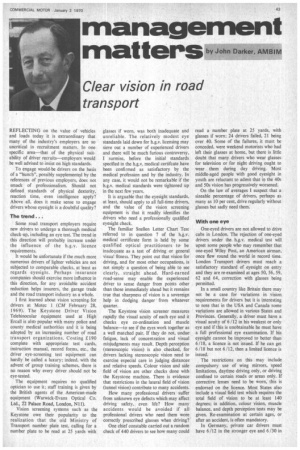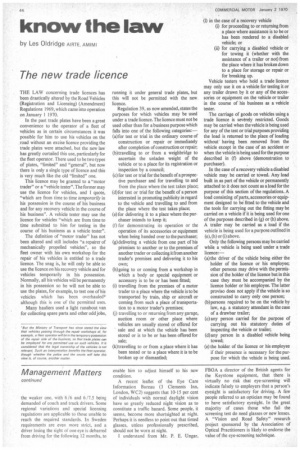management
Page 45

Page 46

If you've noticed an error in this article please click here to report it so we can fix it.
matters by John Darker AMBIM
Clear vision in road transport
REFLECTING on the value of vehicles and loads today it is extraordinary that many of the industry's employers are so uncritical in recruitment matters. In one specific area—that of the physical suitability of driver recruits—employers would be well advised to insist on high standards.
To engage would-be drivers on the basis of a "hunch", possibly supplemented by the references of previous employers, does not smack of professionalism. Should not defined standards of physical dexterity,. reaction time, even intelligence apply? Above all, does it make sense to engage drivers whose eyesight is a doubtful quality?
The trend . . .
Some road transport employers require new drivers to undergo a thorough medical check-up, including an eye test. The trend in this direction will probably increase under the influence of the h.g.v. licence requirements.
It would be unfortunate if the much more numerous drivers of lighter vehicles are not subjected to comparable checks, at least as regards eyesight. Perhaps insurance companies should exercise more influence in this direction, for any avoidable accident reduction helps insurers, the garage trade and the road transport industry as a whole.
I first learned about vision screening.for drivers at Motec 1 (CM February 28, 1969). The Keystone Driver Vision Telebinocular equipment used at High Ercall is also popular with many police and county medical authorities and it is being adopted by an increasing number of road transport organizations. Costing £190 complete with appropriate test cards, instruetion manual, record forms, etc., the driver eye-screening test equipment can hardly be called a luxury; indeed, with the advent of group training schemes, there is no reason why every driver should not be eye-tested.
The equipment requires no qualified optician to use it; staff training is given by the British agents of the American-made equipment (Warwick-Evans Optical Co. Ltd., 272 Palace Road, London, N11).
Vision screening systems such as the Keystone owe their popularity to the realization that the old Ministry of Transport number plate test, calling for a number plate to be read at 25 yards with glasses if worn, was both inadequate and unreliable. The relatively modest eye standards laid down for h.g.v. licensing may sieve out a number of experienced drivers and there will be much furious controversy, I surmise, before the initial standards specified in the h.g.v. medical certifcate have been confirmed as satisfactory by the medical profession and by the industry. In any case, it would not be remarkable if the h.g.v. medical standards were tightened up in the next few years.
It is arguable that the eyesight standards, at least, should apply to all full-time drivers, and the value of the vision screening equipment is that it readily identifies the drivers who need a professionally qualified eyesight check.
The familiar Snellen Letter Chart Test referred to in question 7 of the h.g.v. medical certificate form is held by some qualified optical practitioners to be inadequate as a test of driving or general visua! fitness. They point out that vision for driving, and for most other occupations, is not simply a question of being able to see clearly, straight ahead. Hard-earned road-sense may enable the experienced driver to sense danger from points other than those immediately ahead but it remains true that sharpness of vision is a sovereign help in dodging danger from whatever quarter.
The Keystone vision screener measures rapidly the visual acuity of each eye and it checks eye co-ordination and muscle balance—to see if the eyes work together as a well matched pair. If they do not, undue. fatigue, lack of concentration and visual misjudgments may result. Depth perception (stereoscopic vision) is also checked, for drivers lacking stereoscopic vision need to exercise especial care in judging distances and relative speeds. Colour vision and side field of vision are other checks done with the Keystone machine. There is evidence that restrictions in the lateral field of vision (tunnel vision) contribute to many accidents.
How many professional drivers suffer from unknown eye defects which may affect driving safety, even life? How many accidents would be avoided if all professional drivers who need them wore correctly prescribed glasses when driving?
One chief constable carried out a random check of 440 drivers to see how many could read a number plate at 25 yards, with glasses if worn; 24 drivers failed, 21 being over 40. Some of the failures, it must be conceded, were weekend motorists who had left their glasses at home, but there is little doubt that many drivers who wear glasses for television or for night driving ought to wear them during day driving. Most middle-aged people with good eyesight in youth are reluctant to admit that in the 40s and 50s vision has progressively worsened.
On the law of averages I suspect that a sizeable percentage of drivers, perhaps as many as 10 per cent, drive regularly without glasses but sadly need them.
With one eye
One-eyed drivers are not allowed to drive cabs in London. The rejection of one-eyed drivers under the h.g.v. medical test will upset some people who may remember that one-eyed Wiley Post, an American airman, once flew round the world in record time. London Transport drivers must reach a satisfactory standard of eyesight on entry and they are re-examined at ages 50, 56, 59, 62 and 64, correction with glasses being permitted.
In a small country like Britain there may not be a case for variations in vision requirements for drivers but it is interesting to note that in the USA and Canada some variations are allowed in various States and Provinces. Generally, a driver must have a visual acuity of 6/12 in his weakest or only eye and if this is unobtainable he must have a full professional eye examination. If his eyesight cannot be improved to better than 6/18, a licence is not issued. If he can get 6/18 but not 6/12, then a limited licence is issued.
, The restrictions on this may include compulsory use of wing mirrors, speed limitations, daytime driving only, or driving confined to certain roads or areas only. If corrective lenses need to be worn, this is endorsed on the licence. Most States also include a visual field test which requires the total field of vision to be at least 140 degrees; in addition, colour vision, muscle balance, and depth perception tests may be given. Re-examination at certain ages, or after an accident, is often mandatory.
In Germany, private car drivers must have 6/12 in the stronger eye and 6/30 in the weaker one, with 6/6 and 6 /7.5 being demanded of coach and truck drivers. Some regional variations and special licensing regulations are applicable to those unable to reach the required standards. In Sweden requirements are even more strict, and a driver losing the sight of one eye is debarred from driving for the following 12 months, to enable him to adjust himself to his new condition.
A recent leaflet of the Eye Care Information Bureau (3 Clements Inn, London, WC2) suggests that 10-15 per cent of individuals with normal daylight vision have so greatly reduced night vision as to constitute a traffic hazard. Some people, it seems, become more shortsighted at night. Perhaps it is needless to point out that tinted glasses. unless professionally prescribed, should not be worn at night.
1 understand from Mr. P. E. Ungar, FBOA a director of the British agents for the Keystone equipment, that there is virtually no risk that eye-screening will indicate falsely to employers that a person's eyesight is satisfactory for driving. A few people referred to an optician may be found to have satisfactory eyesight. In the great majority of cases those who fail the screening test do need glasses or new lenses. A "Vision and Road Safety" research project sponsored by the Association of Optical Practitioners is likely to endorse the value of the eye-screening technique.




















































































